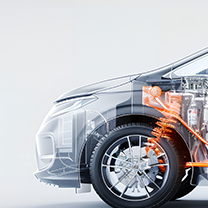
Products
Fast, Reliable, Everywhere

Solutions
Efficient, Innovative EV Charging Solutions.
Charging a hybrid car, especially a plug-in hybrid, is simple. Connect the vehicle to a power source, whether you are at home or at a public charging station.
Below we look at which types of chargers a hybrid car can use and how to use them correctly to keep your car running at peak efficiency.
Hybrid cars can run on electricity alone, rather than just fuel, thus reducing emissions. Here are the different types of hybrid cars:
Full Hybrids (HEVs): Full hybrids like the Toyota Prius and Ford Fusion Hybrid can switch between using their engine and electric motor to get the best fuel efficiency. They recharge their batteries through regenerative braking, so there’s no need to plug them in.
Mild Hybrids: Mild hybrids use a small electric motor to help the main engine run more efficiently, recharging their batteries via regenerative braking. Popular examples include the Chevrolet Malibu Hybrid and Honda Accord Hybrid.
Plug-in Hybrids (PHEVs): Plug-in hybrids, such as the Toyota Prius Prime and Chevrolet Volt, feature larger batteries that you can charge externally. This allows them to drive short distances on electric power alone, with a gasoline engine for longer trips.
Range Extender Hybrids: Range extender hybrids operate mainly on electric power, with a small engine that generates electricity to recharge the battery if it runs low. This setup helps extend the driving range without the need to stop for a recharge, as seen in the BMW i3 REx.
Level 1 chargers are the standard choice and work with any regular 120-volt outlet. However, they charge more slowly, adding about 4 to 5 miles per hour. As such, they are best used when charging an electric vehicle overnight.
Level 2 chargers require a 240-volt power source and can fully charge a hybrid vehicle's battery in just a few hours. They're great for people who need to get their vehicle ready quickly.
Not all hybrids can use DC fast chargers, but for those that can, level 3 EV chargers offer a noticeable charging boost, adding about 60 to 100 miles of range in just 20 minutes, so they're great for long drives.

A portable level 2 charger is a small charging device suitable for home use and very convenient for travel. In addition, some white portable charger models are compatible with standard 120-volt or 240-volt power outlets, while some can only use 240 volts, so you need to consult the EV charger manufacturer.
Charging your hybrid electric vehicle at home is easy and convenient if you have a plug-in hybrid electric vehicle (PHEV). You can follow these steps:
By setting up a home charging station and making it a routine, you will get the most out of your hybrid electric vehicle, reduce fuel costs, and reduce your environmental impact.
Charging a hybrid electric vehicle (PHEV) at a public charging station is simple and similar to charging at home. Here’s how:
By following these steps, you can easily keep your hybrid car's battery topped up while you're out and about, maximizing your vehicle's electric performance.

When your hybrid car is charged at home, its cost is tied to the cost of electricity, which is calculated in cents per kilowatt-hour (kWh). For example, if your electricity cost is $0.13 per kWh and your hybrid car battery holds 10 kWh, a full charge will cost about $1.30. Actual costs will vary depending on when you charge and your energy provider.
If you choose to charge at a public charging station, the cost of public charging stations can vary. Some places offer free charging, while others may charge a flat fee by the hour, per kWh, or per charge. Costs can range from $0.10 per kWh to $0.50 or more, depending on your location and the type of charger.
By understanding the cost of charging at both charging stations, it can be cheaper to charge your hybrid car at home, while public charging stations offer convenience when you're out and about.
Through the above article, we have learned about the different types of chargers that can be used to charge hybrid vehicles, as well as how to use them. With an understanding of charging costs, setup, and best practices for both home and public charging stations, you can ensure that your hybrid vehicle runs efficiently, helping you save fuel and reduce your impact on the environment.
Related reading: How Long to Charge a Hybrid Car?
Can hybrid cars go on long trips?
Hybrid cars are great for long-distance travel. Because they combine a gasoline engine with an electric motor, you can rely on the engine to drive the car when the battery runs low, extending your range. They also tend to be more fuel-efficient, which can save you money on gas on long drives. Note that if you drive a plug-in hybrid, be sure to plan for charging stations.
How to charge hybrid batteries while driving?
Hybrid cars charge their batteries through regenerative braking and the gasoline engine while driving. When you brake or coast, the car converts energy into electricity, which is stored in the battery. The gasoline engine can also supply power to the battery when needed, keeping the battery charged without any extra effort on your part.
How Often Do You Have to Charge a Hybrid Car?
How often a hybrid car needs to be charged is really determined by your driving habits. If you own a plug-in hybrid and often use electric mode, you may find that you need to charge it every day or every few days. For longer trips where the gasoline engine takes over, you won't need to charge it as often. In addition, regular charging helps you make the most of the electric range and saves fuel.
